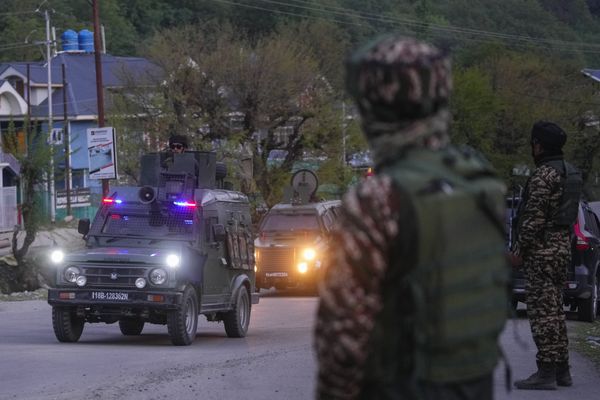"A glowing green mass emerged from a group of elm trees then, as if sucked into the plume of smoke, shot up like a rocket into the sky along with embers in the flame," says a perplexed Scott Mitchell. "It was eerie."
But Scott wasn't the only person at the recent bonfire, held on private land on the shores of Lake George, to notice the "bizarre green blob".

Others who were on the opposite side of the fire from where Scott was filming with his smartphone also noticed a "weird green haze in the elm tree".
Not surprisingly since the bonfire, the unexplained green spectre has been a hot topic of discussion for Scott and his baffled neighbours.
"Did we witness some sort of unusual natural phenomena, like swamp gas?" he asks.

"Some who are into the paranormal even speculated it could have been some sort of ghost," says Scott. "There are so many unusual stories by the lake and the fire was lit on the exact location of an old homestead, so it does make you wonder."
You can't blame people for thinking outside the square, for let's face it, the enigmatic ephemeral lake just 40 kilometres to Canberra's north-east is home to more than its fair share of unusual sightings, some which can be readily explained and others that can't.

Ask any ufologist and they'll tell you the lake is a hotbed for sightings of Unidentified Aerial (or anomalous) Phenomenon (UAPs) - the more modern term to describe unexplainable sights in the sky, not just UFOs.
Many reported UAP sightings near the lake are "a bright yellow light emerging from the mist". These can potentially be explained as Venus rising over the horizon, or the bright lights of a nearby sand mine.
One of the more puzzling of these after-dark accounts occurred in January 1996 near Collector, when a mother and her daughter witnessed not one, but two UFOs land in a paddock adjacent to the lake. She described the object, which "hovered above their car, emitting a number of sparks underneath it", as "large and with rows of coloured lights". Heck.

Even in broad daylight, passers-by have long reported strange sights. In 1839, cattle on the lakebed apparently appeared to be the size of huge trees - no doubt the result of an optical illusion caused by heat haze on the dry lakebed during a hot day. According to the Barrier Miner of January 1, 1898, the "distortion and reflections" looking out from Gearys Gap "were extraordinary", resulting in sheep grazing 5 kilometres away appearing "as big as camels!".
While hydrologists have proven unequivocally that the lake levels are purely the result of evaporation and rainfall, and there is (sadly!) no subterranean connection as some have outlandishly claimed to lakes in Siberia or New Zealand, the murky waters of the lake do harbour some mysteries. This includes the great fish death of 1962, when according to Graeme Barrow in Magnificent: Lake George: The Biography (Dagraja Press, 2012) "many of the lake's millions of carp gulped frantically at the surface for a few minutes, then rolled over dead".

The fish had diseased and bleeding gills and their flesh was riddled with worms which led to bizarre rumours about the cause, including the (completely unproven) dumping of radioactive waste into the lake. The NSW Department of Fisheries formed a team to delve into the sudden fish deaths, but then, according to Barrow, "abandoned the project because carp were considered merely as 'trash' fish and had no economic value. Their deaths did not warrant a long, drawn-out investigation." Case closed.
Now, back to that "green blob" at the bonfire.
When photographs taken on Scott's phone were examined by bushfire experts, they were left clutching straws. "There are many factors (natural and man-made) that can cause fires to exhibit unusual characteristics," wrote one university professor. "Copper and borax (used to treat ants) can cause green flames, but the flames here don't appear to be green, just the smoke". "Its motion is certainly not physical and in no way influenced by the buoyancy and turbulence evident in the plume of the bonfire," concluded another.
However, the video footage tells a different story and when optical mechanic Geoff Kemp of Jerrabomberra viewed it, he was left in no doubt as to the cause.

"There is nothing mysterious at all," he says. "The spectre matches exactly the flames upside-down and reversed and moves with the camera in the opposite direction."
In other words, it's just a rare case of extreme lens flare.
"The colour is caused by the anti-reflective coating on the lens, like the blue-red-green when you look at a camera lens," explains Geoff. "There's a vacuum coating on glass of various metal layers, only atoms thick, that reduces reflections but not entirely, as is exhibited here in this very high-contrast scene."
What Geoff's analysis can't explain is why some bystanders, who weren't looking through a lens, also saw a green haze. Perhaps it was the result of inorganic material burning in the fire.
With a long hot summer predicted, it's likely evaporation will continue to outpace inflows, meaning lake levels will continue to drop from their recent peak. Let's just hope it's still many years before the heat haze on a dry lake bed is such that grazing sheep are confused with camels.
Ever seen Lake George 'water monster'?

If The NSW Gazetteer and Road Guide of 1866 is any indication, rotting fish and submerged fence posts aren't the only hazards to watch out for in the murky depths of Lake George.
The booklet warned travellers to be careful of a large water monster "that occasionally surfaces for air", and that "the lake is surrounded by gigantic, towering mountains". Although the western escarpment does rise steeply above the lake, referring to them as "gigantic mountains" is a long stretch. Given this level of exaggeration, the so-called water monster was probably just a large duck.
But don't mention that too loudly to Canberra cryptozoologist Tony Healy who believes that Lake George and its smaller nearby cousin, Lake Bathurst, ought to be labelled "our haunted lakes" due to the high number of mystery animal reports at both ephemeral bodies of water, including big cats, yowies and that denizen of inland waterways - the bunyip.
"Although there were some rumours of 'marsh monsters' near Sydney in the very early days [of European settlement] it seems the first real involvement of non-Aborigines is the bunyip mystery [that] occurred at Lake Bathurst," pens Healy with co-author Paul Cropper in Out of the Shadows: Mystery Animals of Australia (Pan Macmillan, 1994).
At the lake on April 5, 1818, explorers Hamilton Hume and James Meehan found "skulls and bone fragments of what they thought were large amphibious animals". Strangely, however, the duo didn't take the bones back to Sydney with them, nor did Hume return to collect them, despite the Philosophical Society of Australia offering to pay his expenses.
Meanwhile, the earliest sighting of a "bunyip" was claimed by Edward Smith Hall who in 1821 spotted "an extraordinary creature" and a year later saw it again ... "with long neck, about three feet out of the water and about the thickness of a man's thigh".
WHERE ON THE SOUTH COAST?

Rating: Medium - Hard
Clue: One for the regulars
How to enter: Email your guess along with your name and address to tym@iinet.net.au. The first correct email sent after 10am, Saturday September 16 wins a double pass to Dendy, the Home of Quality Cinema.
Last week: Congratulations to first-time winners Bronwyn Kosman and Paul Howarth of Nicholls who were the first readers to correctly identify last week's photo as a seat atop Percival Hill in Nicholls. The photo was sent in by regular contributor to this column and avid bushwalker Maureen Marshall of Nicholls who reports "there is a plaque on the seat stating it was installed by the Lions Club of Gungahlin", adding "What a brilliant idea as it's so nice to sit and to look out over the Brindabella Ranges and Belconnen area, especially now in spring when there are so many plants flowering." Our winning duo just beat Julie Marks of Palmerston and John Mackinnon of McKellar.

Special note to Greg Norman who had no idea of the location until he went for a walk on Monday to the top of Percival Hill. "That seat looks familiar," he thought. "Sure enough, another read of your column from Saturday on arriving home confirmed it was the same location as your photo quiz," he reports.
"I had to Google to understand your cryptic clue of 'Arthur' though," confesses Greg. Did you get the clue? The hill is named after Arthur Percival, who was Commonwealth surveyor-general and chief property officer in the ACT from 1929-1944. More on Arthur in a future column.
SPOTTED

On a recent adventure through Callum Brae Nature Reserve in Symonston, 12-year-old Gus Lilley and his mum Rose were literally stopped in their tracks by the sight of this leaning tree.
"It looks like an old man with a walking stick, but why is it leaning sideways like that?!" exclaimed Gus, who armed with his new birthday compass, confirmed that the tree was growing towards the east and decided it must just love the morning sun on its tree head". "It was amazing to see new leaf growth sprouting from the old leany tree, which must literally be as old as the hills," reports Rose.
CONTACT TIM: Email: tym@iinet.net.au or Twitter: @TimYowie or write c/- The Canberra Times, GPO Box 606, Civic, ACT, 2601
We've made it a whole lot easier for you to have your say. Our new comment platform requires only one log-in to access articles and to join the discussion on The Canberra Times website. Find out how to register so you can enjoy civil, friendly and engaging discussions. See our moderation policy here.







